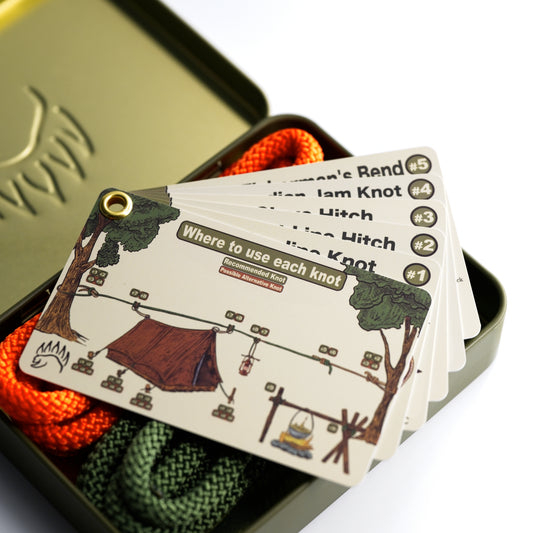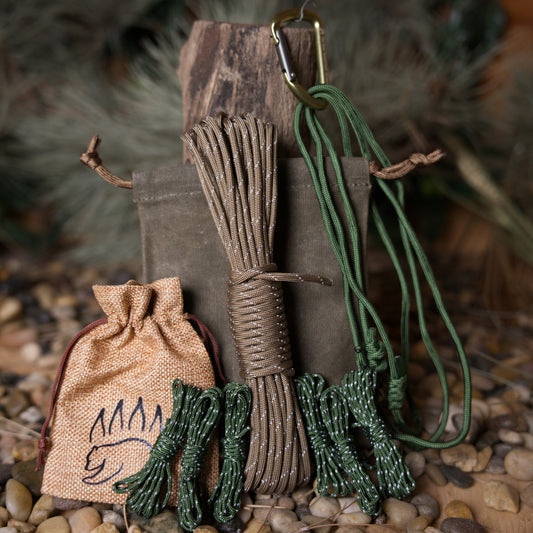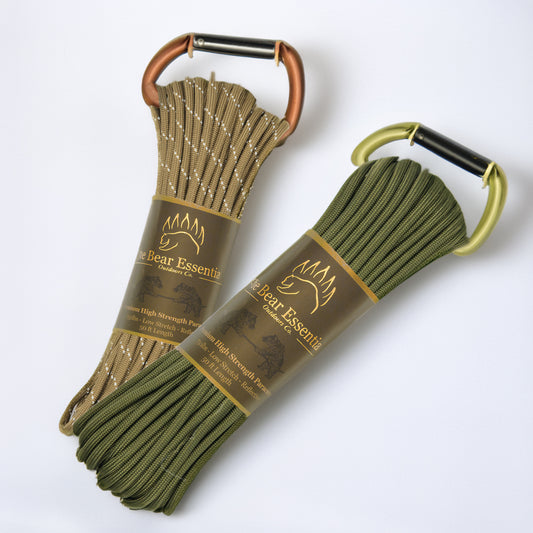How to Tie the Exploding Clove Hitch
Usage
The Exploding Clove Hitch is commonly used to create a quick-release hitch for temporary ties in camping, bushcraft, and utility tasks. Compared to the standard Clove Hitch, it unravels completely with a single pull, making it ideal for tarps or gear needing fast removal. Its simplicity is valued, but it’s less secure for heavy loads.
Why Learn the Exploding Clove Hitch?
Its quick-release design ensures instant untying. This knot is a go-to for outdoor enthusiasts needing fast, temporary ties.
Common Uses
-
Camping:
- Secures tarps to stakes or trees for quick shelter setups.
- Ties guylines for tents, releasing easily when breaking camp.
-
Bushcraft:
- Hangs gear or food bags, untying instantly for access.
- Binds lightweight frames for temporary shelters.
-
Utility:
- Fastens ropes to posts or hooks for short-term tasks.
- Secures loads on vehicles, releasing with a single pull.
ABOK Number
(Ashley Book of Knots)
Other Names
Category
|
Notable Features
- Instant Release: Unties with one pull, perfect for quick takedowns.
- Easy to Tie: Forms rapidly, similar to a standard Clove Hitch.
- Versatile Use: Suits tarps, gear, or temporary camp setups.
- Minimal Rope Use: Requires little cord for effective binding.
- Field-Friendly: Ideal for wet or windy conditions with practice.
Variations
No true variations listed in the provided data. For added security, you can add an extra wrap before slipping the bight, though this may slow release.
Similar Knots
Clove Hitch vs. Exploding Clove Hitch
- Pros: More secure for sustained loads and widely used.
- Cons: Doesn’t release instantly, requiring untying compared to the Exploding version.
Highwayman’s Hitch vs. Exploding Clove Hitch
- Pros: Also quick-release and collapses dramatically for fast removal.
- Cons: More complex to tie and less suited for flat surfaces like poles.
History
The Exploding Clove Hitch, while not explicitly listed in The Ashley Book of Knots, likely evolved from the standard Clove Hitch (#1245) as a quick-release adaptation for outdoor tasks. Its design reflects practical needs in camping and bushcraft for knots that untie instantly, possibly inspired by maritime or pioneering practices. Its modern use in temporary setups underscores its efficiency for rapid release.
Security Level
The Exploding Clove Hitch provides reliable holding for light to moderate loads when tied with proper tension, ideal for temporary ties like tarps or gear. It performs best with textured ropes under consistent tension. For heavy or critical loads, a more secure knot like the Clove Hitch or Round Turn and Two Half Hitches is recommended.
Downsides
- Slipping risk: May loosen if not kept under tension or with slick ropes.
- Not for heavy loads: Less stable than standard hitches for sustained use.
Structure
- Pass the rope around the object (e.g., pole or stake).
- Cross the working end over the standing line to form a loop.
- Make a second loop by crossing the working end over again, but pass a bight (not the end) under the second wrap.
- Pull the standing line to tighten the hitch, ensuring the bight is secure.
- Test the hitch by pulling the bight to confirm it releases instantly.
Pro Tip: Ensure the bight is long enough to pull easily for quick release. Use a textured rope like nylon to improve grip on the object. Practice the release motion to avoid snagging in wet or tangled conditions.
FAQ
Is the Exploding Clove Hitch strong enough for heavy tarps?
It’s reliable for light to moderate tarps, but use a Clove Hitch for heavier loads.
What’s the best rope for the Exploding Clove Hitch?
Nylon or polyester ropes with good grip, like 5-8mm cord, work well.
How does the Exploding Clove Hitch compare to the Highwayman’s Hitch?
Both release quickly, but the Exploding Clove is simpler and better for poles.
Can the Exploding Clove Hitch be used in bushcraft?
Yes, it’s great for hanging gear or temporary shelters needing fast release.
Why choose the Exploding Clove Hitch over a standard Clove Hitch?
It unties instantly with one pull, ideal for temporary, quick-release ties.
Important Notes on Safety
Common failure points include a loose bight or insufficient tension, which can cause slipping. Always verify the hitch is tight and secure before relying on it. Check the rope for wear or slickness before tying. Ensure the bight is properly slipped for instant release. Practice in low-stakes settings to master tying and releasing.







